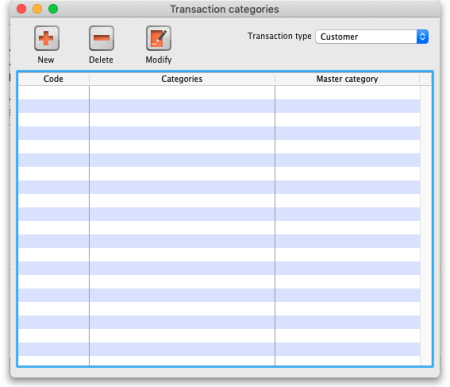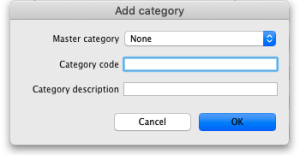26.06. Transaction categories
Categorising transactions allows you to group transactions together when reviewing or reporting them. Each type of transaction can have its own list of categories. For example customer invoices might have a category “normal” and “urgent”. Inventory adjustements might have categories “expired”, “damaged”, “stocktake”, “annual stockatake” or “monthly stocktake” etc.
From the Special menu, choose Transaction categories… to see this window:
First of all, select the transaction type the categories you create will belong to in the Transaction type drop down list. Customer (which refers to customer invoices) is selected by default so the table will contain all the previously created customer invoice categories.
Click on “New” button to create a new category and this window appears:
Here you enter the details of the category:
- Master category: select the master category that this one will belong to. Master categories are a way of grouping other transaction categories together, even categories of different types, to make reporting easier (see section 11.03. Transaction reports, Transaction category filter for details of how master transaction categories can be used in reporting). Master transaction categories are fixed in the system and cannot be edited. Those available are:
- Damaged
- Expired
- Found
- Lost
- Stocktake
- Stolen
- Other
- Category code: the code of the transaction category. Not displayed in mSupply but you can filter categories by this so it provides another way to select relevant categories when reporting.
- Category Description: the name of the category, visible throughout mSupply. Also filterable when reporting.
Once you have created transaction categories they will be selectable in a drop down list when you create a new invoice or transaction.
For systems using Remote Synchronisation, Transaction Categories are 'System' data and can only be edited on the Primary Server. Any edits then synchronise to all relevant satellites.
There is a 'server' preference to Require category entry on customer invoices. This would apply to all customer invoices issued for all stores Active on the server.
See the 28.08. How to report by invoice category section for details on how to use the transaction categories in reporting.
| Previous: 26.05. Edit menu | | Next: 26.07. Virtual stores |

